Related Research Articles

The Wars of Scottish Independence were a series of military campaigns fought between the Kingdom of Scotland and the Kingdom of England in the late 13th and early 14th centuries.
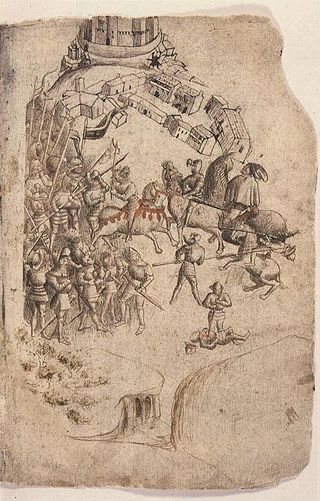
The Battle of Bannockburn fought on 23–24 June 1314, was a victory of the army of King of Scots Robert the Bruce over the army of King Edward II of England in the First War of Scottish Independence. It was a major turning point in the war, which only officially ended 14 years later with the de jure restoration of Scottish independence under the Treaty of Edinburgh–Northampton; for this reason, Bannockburn is considered a landmark moment in Scottish history.
The Battle of Halidon Hill took place on 19 July 1333 when a Scottish army under Sir Archibald Douglas attacked an English army commanded by King Edward III of England and was heavily defeated. The year before, Edward Balliol had seized the Scottish Crown from five-year-old David II, surreptitiously supported by Edward III. This marked the start of the Second War of Scottish Independence. Balliol was shortly expelled from Scotland by a popular uprising, which Edward III used as a casus belli, invading Scotland in 1333. The immediate target was the strategically-important border town of Berwick-upon-Tweed, which the English besieged in March.
The Battle of Dupplin Moor was fought between supporters of King David II of Scotland, the son of King Robert Bruce, and English-backed invaders supporting Edward Balliol, son of King John I of Scotland, on 11 August 1332. It took place a little to the south west of Perth, Scotland, when a Scottish force commanded by Donald, Earl of Mar, estimated to have been stronger than 15,000 and possibly as many as 40,000 men, attacked a largely English force of 1,500 commanded by Balliol and Henry Beaumont, Earl of Buchan. This was the first major battle of the Second War of Scottish Independence.
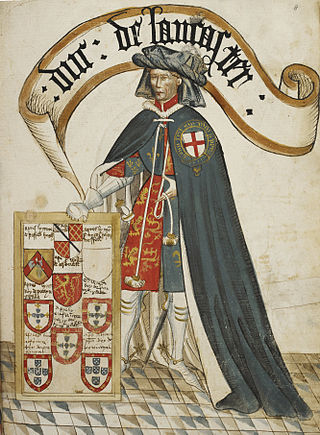
Henry of Grosmont, Duke of Lancaster was an English statesman, diplomat, soldier, and Christian writer. The owner of Bolingbroke Castle in Lincolnshire, Grosmont was a member of the House of Plantagenet, which was ruling over England at that time. He was the wealthiest and most powerful peer of the realm.
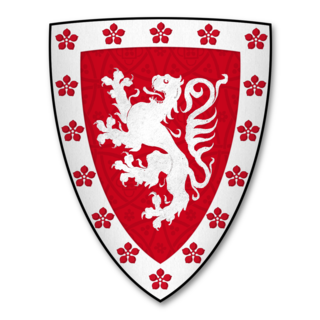
Patrick de Dunbar, 9th Earl of March, was a prominent Scottish magnate during the reigns of Robert the Bruce and David II.

The Battle of Culblean was fought on 30 November 1335, during the Second War of Scottish Independence. The Scots, led by the Guardian, Sir Andrew Murray, achieved victory over an Anglo-Scots force commanded by David III Strathbogie, titular Earl of Atholl and a leading supporter of Edward Balliol.
Sir Archibald Douglas was a Scottish nobleman, Guardian of Scotland, and military leader. He is sometimes given the epithet "Tyneman", but this may be a reference to his great-nephew Archibald Douglas, 4th Earl of Douglas. He fought and died at the Battle of Halidon Hill.
Events from the 1310s in England.
The sack of Berwick was the first significant battle of the First War of Scottish Independence in 1296.
The Second War of Scottish Independence broke out in 1332 when Edward Balliol led an English-backed invasion of Scotland. Balliol, the son of a former Scottish king, was attempting to make good his claim to the Scottish throne. He was opposed by Scots loyal to the occupant of the throne, eight-year-old David II. At the Battle of Dupplin Moor Balliol's force defeated a Scottish army ten times their size and Balliol was crowned king. Within three months David's partisans had regrouped and forced Balliol out of Scotland. He appealed to the English king, Edward III, who invaded Scotland in 1333 and besieged the important trading town of Berwick. A large Scottish army attempted to relieve it but was heavily defeated at the Battle of Halidon Hill. Balliol established his authority over most of Scotland, ceded to England the eight counties of south-east Scotland and did homage to Edward for the rest of the country as a fief.
Sir Andrew Murray (1298–1338), also known as Sir Andrew Moray, or Sir Andrew de Moray, was a Scottish military and political leader who supported King David II of Scotland against Edward Balliol and King Edward III of England during the Second War of Scottish Independence. He held the lordships of Avoch and Petty in north Scotland, and Bothwell in west-central Scotland. In 1326 he married Christina Bruce, a sister of King Robert I of Scotland. Murray was twice chosen as Guardian of Scotland, first in 1332, and again from 1335 on his return to Scotland after his release from captivity in England. He held the guardianship until his death in 1338.
Sir Alexander Seton, also known as Alexander de Seton, was a 13th–14th-century noble. He was married to Margaret Murray. He died during the Battle of Kinghorn on 6 August 1332.

Sir Alexander Seton, also known as Alexander de Seton was the Governor of Berwick.
The Battle of Kinghorn was fought on 6 August 1332 at Wester Kinghorn, Fife, Scotland. An invading seaborne force of 1,500 men was commanded by Edward Balliol and Henry Beaumont, Earl of Buchan. A Scottish army, possibly 4,000 strong, commanded by Duncan, Earl of Fife, and Robert Bruce, Lord of Liddesdale was defeated with heavy loss. Balliol was the son of King John Balliol and was attempting to make good his claim to be the rightful king of Scotland. He hoped that many of the Scots would desert to him.
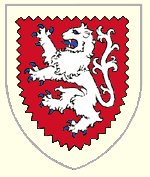
Sir Thomas Grey of Heaton Castle in the parish of Cornhill-on-Tweed, Northumberland, was a soldier who served throughout the Wars of Scottish Independence. His experiences were recorded by his son Thomas Grey in his chronicles, and provide a rare picture of the day to day realities of the Wars.
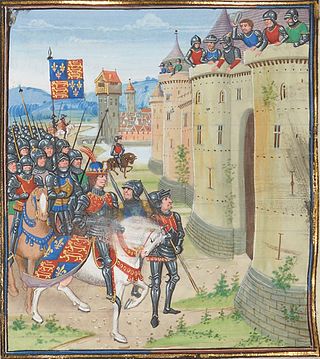
The siege of Berwick lasted four months in 1333 and resulted in the Scottish-held town of Berwick-upon-Tweed being captured by an English army commanded by King Edward III. The year before, Edward Balliol had seized the Scottish Crown, surreptitiously supported by Edward III. He was shortly thereafter expelled from the kingdom by a popular uprising. Edward III used this as a casus belli and invaded Scotland. The immediate target was the strategically important border town of Berwick.
The English invasion of Scotland of 1296 was a military campaign undertaken by Edward I of England in retaliation to the Scottish treaty with France and the renouncing of fealty of John, King of Scotland and Scottish raids into Northern England.
Burnt Candlemas was a failed invasion of Scotland in early 1356 by an English army commanded by King Edward III, and was the last campaign of the Second War of Scottish Independence. Tensions on the Anglo-Scottish border led to a military build-up by both sides in 1355. In September a nine-month truce was agreed, and most of the English forces left for northern France to take part in a campaign of the concurrent Hundred Years' War. A few days after agreeing the truce, the Scots, encouraged and subsidised by the French, broke it, invading and devastating Northumberland. In late December the Scots escaladed and captured the important English-held border town of Berwick-on-Tweed and laid siege to its castle. The English army redeployed from France to Newcastle in northern England.
The sieges of Berwick were the Scottish capture of the town of Berwick-upon-Tweed on 6 November 1355 and their subsequent unsuccessful siege of Berwick Castle, and the English siege and recapture of the town in January 1356. In 1355 the Second War of Scottish Independence had been underway for over 22 years. After a period of quiescence the Scots, encouraged by the French who were fighting the English in the Hundred Years' War, assembled an army on the border. In September a truce was agreed and much of the English army left the border area to join King Edward III's campaign in France.
References
- Brown, Michael (2008). Bannockburn: The Scottish War and the British Isles 1307-1323: The Scottish War and the British Isles 1307-1323. Edinburgh University Press. ISBN 9780748633340.
- Dalrymple, Sir David (1819). Annals of Scotland: From the Accession of Malcolm III. in the Year M.LVII. to the Accession of the House of Stewart in the Year M.CCC.LXXI. To which are Added, Tracts Relative to the History & Antiquities of Scotland. Vol. 2. Edinburgh: A. Constable & Co. OCLC 150903449.
- Nicholson, Ranald (1961). "The Siege of Berwick, 1333". The Scottish Historical Review. XXXX: 19–42. OCLC 664601468.
- Prestwich, Michael (2007). Plantagenet England 1225-1360 - Volume 8 of New Oxford history of England. Oxford University Press. ISBN 9780199226870.
- Seton, Bruce Gordon (1939). The House of Seton: A Study of Lost Causes (PDF). Vol. I. Edinburgh: Lindsay and MacLeod. OCLC 54562178.
- Sumption, Jonathan (1990). Trial by Battle. The Hundred Years War. Vol. I. London: Faber and Faber. ISBN 978-0-57120-095-5.